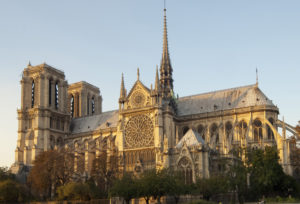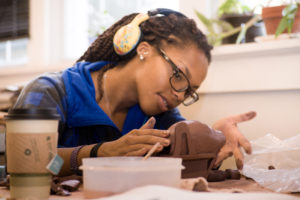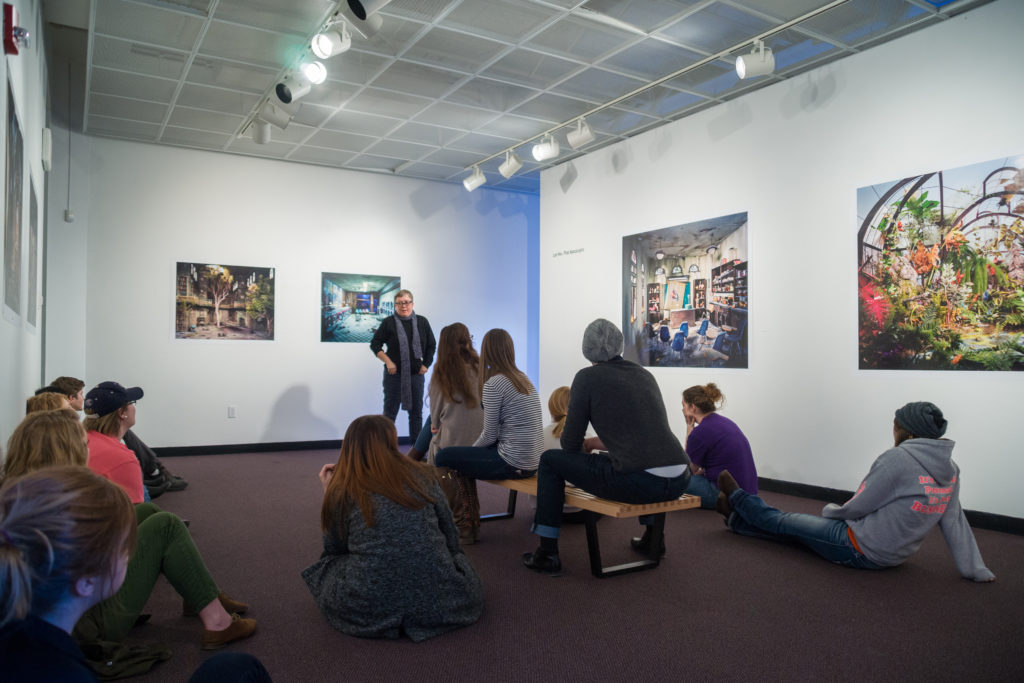 As Notre-Dame burned in April, the world watched. Network television interrupted regularly scheduled programming in favor of continuous coverage. A structure in existence for more than 800 years being decimated on live television is the kind of out-of-the-ordinary event that makes people stop and pay attention. By most reasonable standards, the cathedral was already considered old when America was discovered. It was the site of Napoleon’s coronation. It survived the French Revolution and two world wars. Its apparent demise was rightfully a where-were-you-when moment, but something made it larger than just a dark day for the country of France or the Catholic Church. Nearly every journalist covering the event made mention of the art and artifacts housed inside, and many more noted that the structure itself is a masterpiece. People from all walks of life, no matter their nationality or religious affiliation, could relate to that aspect of the story. There is a reason Notre-Dame attracts some 14 million visitors a year. Even the most secular individuals can look at its stained-glass windows and see beauty, or respect the craftsmanship in its sculptural decorations. Musicians appreciate its massive pipe organ, and those without even a bit of architectural knowledge are awed by its ribbed vaults and flying buttresses.
As Notre-Dame burned in April, the world watched. Network television interrupted regularly scheduled programming in favor of continuous coverage. A structure in existence for more than 800 years being decimated on live television is the kind of out-of-the-ordinary event that makes people stop and pay attention. By most reasonable standards, the cathedral was already considered old when America was discovered. It was the site of Napoleon’s coronation. It survived the French Revolution and two world wars. Its apparent demise was rightfully a where-were-you-when moment, but something made it larger than just a dark day for the country of France or the Catholic Church. Nearly every journalist covering the event made mention of the art and artifacts housed inside, and many more noted that the structure itself is a masterpiece. People from all walks of life, no matter their nationality or religious affiliation, could relate to that aspect of the story. There is a reason Notre-Dame attracts some 14 million visitors a year. Even the most secular individuals can look at its stained-glass windows and see beauty, or respect the craftsmanship in its sculptural decorations. Musicians appreciate its massive pipe organ, and those without even a bit of architectural knowledge are awed by its ribbed vaults and flying buttresses.
One of the beautiful things about art is there are no boundaries. Medium, subject matter, message and intent are all limited only by the whims of the creator …
Few things have had a larger influence on the world than the arts. Art is ubiquitous, so much so that it is hard to encapsulate what is even meant by “the arts.” To some, it is the classical branches of painting, sculpture and architecture. Hardly anyone would argue a broader definition of art to include music, theatre, film, dance and literature. One of the beautiful things about art is there are no boundaries. Medium, subject matter, message and intent are all limited only by the whims of the creator, and the end result, whatever it may be, stands on its own. Good, bad, fantastic, awful – it is all relative to the individual. There is no right or wrong answer. A single painting has the ability to move some people to tears, while others might feel their dog could complete a better composition.
The relationship with the arts begins at an early age. Lullabies sooth babies to sleep. By the time those same children are toddlers they pictorialize the world they know and utilize the family refrigerator as their gallery. Tiny dancers bring works of art to life during recitals while proud parents film their routines to share through yet another medium with captive audiences at family reunions. After the kids have traded in the dance shoes, they spend their time enthralled with video games, putting in hour after hour on an elaborate distraction built by a team of graphic designers and computer scientists who devoted years of their lives to the project. By college, some of the more successful members of garage bands have moved on to actual paying gigs, and others finally work up the courage to try out their stand-up routine at the local open mic. Many people make the arts a lifelong pursuit, even if it is just a hobby – sometimes as consumers, other times as creators. They play an instrument, visit art galleries, spend hours binge watching a television series, participate in community theatre or sing in the church choir for no other reason than love for their chosen outlet.
Civilizations are often defined by their art. Mention of Egypt immediately brings to mind images of hieroglyphics featuring gods and pharaohs. Elaborate ink paintings, calligraphy on silk or paper, and woodblock prints are all associated with Japan. Even novices think of Italy when shown the works of Michelangelo or Da Vinci. This concept also applies to humanity writ large. When the Voyager spacecrafts launched in 1977 they included phonograph records featuring sounds and images indicative of life on Earth. Among the musical selections were works by Bach, Mozart, Beethoven and Stravinsky, along with more contemporary songs by Blind Willie Johnson and Chuck Berry. Art is so important to humanity some felt it needed to be one of the first things extraterrestrials should know about Earth. It is possible an alien creature will one day form its first opinion about the planet based on “Johnny B. Goode.”
“Human beings have always been creating art in some form or fashion. I feel it is an innate part of who we are as a species,” said Akela Cooper (’03).
One of the countless University alumni who have gone on to a career in an artistic field, Cooper is a television and film writer and executive producer. Her credits include “Luke Cage,” “American Horror Story,” “Grimm” and “The 100.”
“The ability to entertain people, to emotionally affect them, is a great responsibility because art and entertainment have the potential to influence culture and even change minds. Hopefully for the better,” Cooper said.
Almost everyone has something that resonates with them …
Art means different things to different people, but the influence it has can certainly be profound. Almost everyone has something that resonates with them, whether it is the book they read over and over, the movie that inspired a career change or the song they share with their significant other.
Some previous methods of thinking may have viewed the arts as solely a pleasurable pursuit, lacking in the ability to make substantive contributions to the world. Starting sometime in the 1990s, many in education circles rallied behind the idea of STEM, which stands for science, technology, engineering and math. The belief was schools should encourage those aspects of education to make graduates more valuable in the workplace. Statistically speaking, there is no denying that logic. There are only so many spots in the London Philharmonic or the New York City Ballet, and a student is far more likely to be needed in a field where a solid grasp of science, technology, engineering or math would be useful.
However, while the STEM disciplines are certainly valuable, the philosophy behind that take on education has been revisited in recent years. Advances occur so rapidly now that technical knowledge alone can quickly become obsolete. Creative skills contribute to problem solving, or the seamless integration of concepts for practical use. Art and design can go hand in hand with technology (Apple, anyone?) and therefore many in the education industry have added an A into those critical fields of study, turning STEM to STEAM.
“There is a lot of value to STEAM education,” said Sarah Berke, assistant professor of biology. “While the arts represent many things, I like to sum it up as creativity and innovation. Those are central to STEM, and without them we are not successful.”
Berke is a leader in the Kirksville STEAM Alliance, a collaborative network of educators, business affiliates and organizations that inspires interest and facilitates activity in science, technology, engineering, arts and mathematics careers to generate and retain a robust workforce in the region. She sees how the relationship between STEM and the arts goes both ways. Not only does infusing creativity help make the original disciplines better, it also opens them up to more people.
“The inclusion of the arts allows us to reach more students, those that are perhaps scared of STEM, and show them how to appreciate or see the importance of STEM through art,” Berke said.
It is human nature to create and consume art.
As valuable and necessary as traditional career paths can be, they are not always the answer. Laura McHugh (’96) earned a degree in creative writing, but wanted the security of a stable job and income. She added a bachelor’s degree and master’s degree in tech-related fields, however, the stability she sought was not there in the long run.
“The arts seemed too risky as a career path, so I spent 10 years working in tech,” she said. “When I lost my job in the recession, I decided to pursue the one thing I was most passionate about: writing. I knew I’d regret it if I never tried.”
Doing what she loved paid off for McHugh, literally. Today, she is an award-winning, international bestselling author with three novels to her credit.
“Our world is so much richer thanks to the creative contributions of artists,” she said. “Try to imagine life without music, stories and visual arts to inspire us, entertain us, comfort us, expose us to different perspectives.”
 Putting aside the philosophical debate of whether life imitates art or art imitates life, there is no denying art is intrinsically valuable. Art for the sake of art serves a purpose. It is human nature to create and consume art. Not only does it entertain and help to pass the time, it affects each person in their own way. That alone makes it worthwhile.
Putting aside the philosophical debate of whether life imitates art or art imitates life, there is no denying art is intrinsically valuable. Art for the sake of art serves a purpose. It is human nature to create and consume art. Not only does it entertain and help to pass the time, it affects each person in their own way. That alone makes it worthwhile.
“Studying any art form in school or in life is important because it gives you a greater understanding of humanity and our place in the world,” said opera singer and University alumnus Dominic Armstrong (’02).
Since his graduation from Truman, Armstrong has established himself internationally as an artist of superb and distinguished musicality and characterization. He has taken the stage at Carnegie Hall in New York City and many other theatres the world over, but he knows full well the struggles of a career in the arts. Rejection, along with inconsistency in income and routine, are just a few of the things that can cause aspiring artists to question their choices.
“The world we live in seems to get more and more commercial with every passing year. If you can’t find a way to make your passion into a ‘marketable skill’ it feels as though the modus operandi is to say ‘well, if you aren’t making money at it, it must not be valuable,’” Armstrong said. “I reject this view. My hope is that our society can return to a position of learning for learning’s sake. Learning a new skill, practicing a new passion, reading a play, listening to an opera or a symphony – just learning – is a benefit to you and therefore the world around you. When you sing a song, the text becomes more meaningful. When you speak text from a play, you empathize with a character, which helps you reexamine predetermined beliefs. Art gives you a better understanding of life, and society is better for it.”
Anyone who puts their passion into a project, or who takes an idea in their head and makes it a reality in the world is, in a sense, an artist. As society progresses and there are more means to create, there will also be an expanding definition as to what constitutes art. Arguably, the main function of art is for it to be experienced, to evoke an emotion or elicit a reaction. Rather than try to categorize it, to try and figure out what is good art or what practical purpose it may serve, the wiser choice might be to just take a moment to enjoy it.


